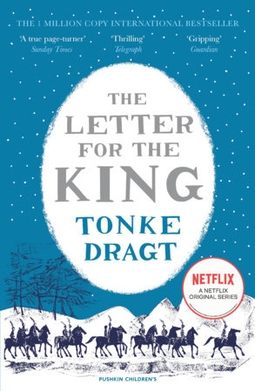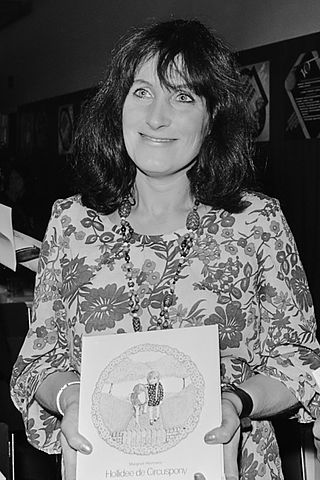
Paulus Johannes "Paul" Biegel was a successful and prolific Dutch writer of children's literature.

The Gouden Griffel is an award given to authors of children's or teenagers' literature in the Netherlands.

Guus Kuijer is a Dutch author. He wrote books for children and adults, and is best known for the Madelief series of children's books. For his career contribution to "children's and young adult literature in the broadest sense" he won the Astrid Lindgren Memorial Award from the Swedish Arts Council in 2012, the biggest prize in children's literature. As a children's writer he was one of five finalists for the biennial, international Hans Christian Andersen Award in 2008.
Marinus Franciscus Johannes "Marijn" Backer is a Dutch educator, poet, and writer.

Antonius Otto Hermannus (Toon) Tellegen is a Dutch writer, poet, and physician, known for children's books, especially those featuring anthropomorphised animals, particularly those about an ant and a squirrel. His writings are also enjoyed by adults, due to the amusing, bizarre situations that Tellegen creates, as well as their dealings with philosophical subjects.

The Letter for the King is a book by the Dutch writer Tonke Dragt, first published in 1962. Proceeding, The Secrets of the Wild Wood, was published in 1965, and a collection of follow-up short stories, The Dangerous Window and other stories, in 1979. De brief voor de koning was chosen as the best Dutch youth book of the latter half of the 20th century.
Laura Watkinson is a British literary translator. She studied languages at St Anne's College, Oxford, and has obtained some postgraduate qualifications since. She has taught at the University of Erlangen-Nuremberg and University of Milan.

Margaretha Henrica Gerardus Maria Heijmans was a Dutch writer and illustrator of children's literature.
The Nienke van Hichtum-prijs is a biennial Dutch literary award for children's literature awarded by the Jan Campert-Stichting. The award is named after children's author Nienke van Hichtum and was first awarded in 1964. The winner of the prize receives €6,000.
Harriët van Reek is a Dutch writer and illustrator of children's literature.

Miep Diekmann was a Dutch writer of children's literature.

Els Pelgrom, pseudonym of Else Koch, is a Dutch writer of children's literature. Pelgrom is the only author to have received the Gouden Griffel award three times.
In the Netherlands, the Vlag en Wimpel award is an honourable mention awarded by either the jury of the Gouden Griffel and Zilveren Griffel awards or the jury of the Gouden Penseel and Zilveren Penseel awards. The award is organised by the Collectieve Propaganda van het Nederlandse Boek. Starting in 2022, instead of Flags and Pennants, Bronze Griffels and Bronze Brushes will be awarded. The name change is intended to underscore the purpose of these awards: to highlight the best children's books.
Ingrid Godon is a Flemish illustrator of children's literature.
André Sollie is a Belgian author and illustrator of children's literature.
Sjoerd Kuyper is a Dutch poetry and prose writer of adult, children's and youth books, theatre, TV series, film scripts and lyrics. His best-known works are the film Het zakmes, the series of books about the toddler Robin, the poem Mensen met koffers, the lyrics Hallo wereld and the youth novels Hotel De Grote L and Bizar (Bizarre). His books have been published in fifteen countries. He has won, among other things, six Zilveren Griffels and a Gouden Griffel for Robin en God. In 2012 he was awarded the Theo Thijssen Prijs for his entire oeuvre, and in 2014 he was appointed Officier in de Orde van Oranje-Nassau for his merits in Dutch literature at home and abroad.
Annemarie van Haeringen is a Dutch illustrator. She won the Gouden Penseel award three times: in 1999, 2000 and 2005.
The Letter for the King is a coming-of-age fantasy adventure television series developed by Will Davies and FilmWave for Netflix inspired by the classic 1962 Dutch novel De brief voor de Koning by Tonke Dragt. The six-episode series was released on Netflix on 20 March 2020.

Paul van Loon is a Dutch writer of children's literature. His best-known books are the series about Dolfje Weerwolfje and the series De Griezelbus . These books were adapted into a musical and a movie. The series Raveleijn also became one of his best known works after the appearance of a television series and of an amusement park show in Efteling.

The Secrets of the Wild Wood is a Dutch children's book written by Tonke Dragt in 1965. It is a sequel to The Letter for the King, which has been adapted to a feature film and a Netflix series. The book was translated to English by Laura Watkinson in 2015.











